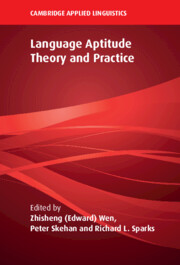Book contents
- Language Aptitude Theory and Practice
- The Cambridge Applied Linguistics Series
- Language Aptitude Theory and Practice
- Copyright page
- Contents
- Figures
- Tables
- Editors and Contributors
- Preface and Acknowledgments
- 1 Language Aptitude Research
- Part I Revisiting and Refining Aptitude Tests
- Part II Aptitude Testing of Diverse Groups
- Part III Innovative Perspectives and Paradigms
- Part IV Aptitude–Treatment Interaction (ATI)
- Part V Final Commentaries
- 17 Reflections on Aptitude
- 18 Epilogue
- Index
- References
17 - Reflections on Aptitude
Theory, Research, and Measurement
from Part V - Final Commentaries
Published online by Cambridge University Press: 27 May 2023
- Language Aptitude Theory and Practice
- The Cambridge Applied Linguistics Series
- Language Aptitude Theory and Practice
- Copyright page
- Contents
- Figures
- Tables
- Editors and Contributors
- Preface and Acknowledgments
- 1 Language Aptitude Research
- Part I Revisiting and Refining Aptitude Tests
- Part II Aptitude Testing of Diverse Groups
- Part III Innovative Perspectives and Paradigms
- Part IV Aptitude–Treatment Interaction (ATI)
- Part V Final Commentaries
- 17 Reflections on Aptitude
- 18 Epilogue
- Index
- References
Summary
The present volume has explored a very wide range of topics within the field of foreign language aptitude with sections covering aptitude test batteries, the testing of diverse groups, innovative perspectives, and pedagogic implications. Each chapter has made a considerable contribution to updating the topic of aptitude. Inevitably, though, the chapters have explored areas that transcend the different heading sections, making new connections and even announcing new areas for aptitude research. The present chapter highlights all of these insights and weaves them into the discussion of a series of themes which emerge, some traditional from established aptitude work and some reflecting the changes we have seen in recent years.
- Type
- Chapter
- Information
- Language Aptitude Theory and Practice , pp. 443 - 467Publisher: Cambridge University PressPrint publication year: 2023

